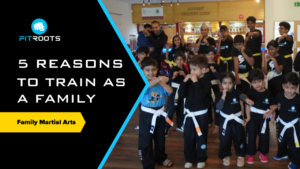There is so much advice out there telling you what the benefits of Martial Arts are.
These include self-defence, confidence, strength, discipline, focus, respect… The list goes on.
While these are valuable benefits, we are sure you would like to know about the flip side.
Because let’s be honest, there are pros and cons to everything.
Here you will find out the top 7 Problems With Martial Arts and their solutions.
1 – There Are Too Many Martial Arts To Choose From
First of all, too many choices at your fingertips creates the feeling of FOMO (Fear Of Missing Out), leaving us dissatisfied and disappointed.
As a result, one big problem for you when choosing a Martial Art is ‘overchoice’.
Making a decision becomes overwhelming due to the many potential outcomes and risks that may result from making the wrong choice.
With Martial Arts, ‘too many choices’ becomes an understatement.
Karate, Muay Thai, Kickboxing, Wing Chun, Kung Fu, MMA, Tai Chi…
In fact, there are hundreds of styles of Martial Arts, and there would be no way that you could try all of them to find the right one for you.
Among the hundreds of styles offered, it can be hard to understand what ‘style’ you should learn.
But here is a simple break down of the Martial Arts categories that will hopefully help you on your journey.
Styles typically fall under these four categories:
Striking Martial Arts
Examples include:
Kickboxing, Boxing, Wing Chun, Karate, Taekwondo, Capoeira, Muay Thai, Kung Fu, Pencak Silat
Many beginners start here due to the popularity of these styles. There is less continuous close contact in striking arts than in grappling arts, although you may find elements of grappling in striking arts too.
Grappling Martial Arts
Examples include:
Hapkido, Judo, Sumo, Wrestling, Aikido, Jujutsu, Brazilian Jiu- Jitsu, Sambo, Kung Fu
While there are no direct impacts from kicks or punches in grappling arts, be prepared to have your whole body thrown around. Grappling arts are more focused on taking control of your opponent’s body.
Armed Martial Arts
Examples include:
Eskrima, Silat, Kalaripayattu, Kobudo, Kenjutsu, Kendo, Bojutsu, Kyudo, Fencing
Armed arts focus on the use of weapons and range, from using short sticks all the way to swords and other sized weapons.
Health and Spiritual Martial Arts
Examples include:
Bone Setting, Herbalism, Traditional Medicine, Tai Chi, Qigong, Baguazhang
Many of these Martial Arts lead to improvement in wellbeing, confidence, and stress, without the use of combat or competition.
Solution
When you are deciding which Martial Art to learn, have a think about what your intention is.
Are you looking to pick up some practical self-defence skills, or are you looking to find something that focuses more closely on your health and wellbeing?
First look at the four types; Striking, Grappling, Armed, Health and Spiritual, then decide which style or styles you would be most interested in.
Some factors you can consider are:
- The level of close contact you are willing to participate in
- The speed of the class
- Are you learning for practical self-defence?
- How patient are you?
- Do you enjoy unconventional activities?
2 – Martial Arts Are Too Violent
Many people think that learning Martial Arts promotes violence, and this comes as no surprise, especially as Martial Arts were derived from war.
Let’s Take a Look At How Martial Arts Started?
The term ‘Martial Arts’ originates from Latin, and means ‘arts of Mars’. Referring to Mars, who was the Roman god of war.
Others have dubbed it the ‘Art of War’ after the ancient Chinese military treatise by Sun Tzu, which was created around 5th Century BCE.
Maybe, this has left many with the problem that Martial Arts are too violent for modern times.
Whilst this is the literal definition, Martial Arts are organised systems and codes of combat, which are primarily for physical, mental, spiritual development, and self-defence.
Sure, the idea that practicing an aggressive art can make you less aggressive seems a paradox. Yet this belief forms the foundation of many Martial Arts, dating back thousands of years.
What Else Is Martial Arts About?
Martial Arts is not only about striking or grappling, that is just the instrument (for some).
They are based upon moral codes of conduct including; honour, discipline, respect, loyalty, and self-control.
Bruce Lee once said ‘…emotion can be the enemy. If you give into your emotion, you lose yourself.’
Solution
With the advent of more peaceful times in modern day life, the need for learning Martial Arts in its original sense of our survival is no longer necessary. However, what is necessary, is a pursuit of excellence in body, mind, and spirit, and ultimately, this is what a modern Martial Art should express.
Martial Arts in this sense, will allow you to express yourself though its very nature, and help mould you into the person you wish to become.
Put time into researching the right Martial Arts School for you. Find a school that teaches their students to understand how to channel their new skills, and to use them in a positive way.
Remember, Martial Arts is only violent if you are violent.
3 – Martial Arts Are Not Practical
Martial Arts taught today often raises controversy in the West, which may leave you to wonder if they can be used in reality.
Contrary to popular belief, not all Martial Artists practice for self-defence. Some practice solely for health, or the ‘arts’ too.
Martial Arts in general can be used for health when practiced slowly, and for self-defence when practiced fast.
Despite these benefits, even the most practical of Martial Arts are now being challenged.
Martial Arts In The West – What Happened?
It is no secret that as Asian Martial Arts came to the west, they were commercialised and turned into ‘Black Belt factories’.
Furthermore, this encourages mums and their kids to earn a Black Belt, just so they can show it off to their friends and families.
A similar thing happened to Boxing and Kickboxing clubs. Businessmen saw an opportunity to start churning out fighters. The arts behind Martial Arts were lost to the money. And nowadays, any average Joe and his dog is a boxer with a Black Belt.
Achieving a Black Belt once meant something, it meant that you had a level of dedication and skill that few others would be able to achieve.
Consequently, now it means nothing. You have 10 year olds ‘earning’ Black Belts.
Solution
Find a Martial Art that suits your needs, there is something for everyone. Just because it isn’t for you, it doesn’t mean it’s impractical, maybe it is impractical for your needs.
Maybe all you want is for your child to earn a Black Belt, and if that’s true, be honest. It will make your search for your perfect Martial Arts School a lot easier and quicker.
If you’re looking for self-defence, look at the harder Martial Arts out there, but if you’re looking for something softer check out the Health and Spiritual Martial Arts above.
Real Dojos (Martial Arts practice areas) are becoming harder to find, but they are out there.
Read our 5 signs Of A Bad Martial Arts School here to help you when you are looking around.
4 – Why Does It Take So Long To Learn Martial Arts?
Many traditional Martial Arts are based on a lifetime of practicing. They are not designed to pump out fighters in a 12 week bootcamp, they are designed to be a way of life.
This can often stand in our way, and become a problem for our modern-day Western lifestyle. We favour convenience and instant gratification.
For this reason, many Martial Arts Schools dilute the teaching process at the cost of teaching legitimate, quality Martial Arts.
Beware of the 4 year Black Belt programme.
Gone are the days of ‘wax on, wax off,’ where you learnt patience before striking.
How Long Does It Take To Learn Martial Arts?
As you develop in Martial Arts, there will be varying amounts of understanding, and learning involved. Therefore, you will need guidance along the way.
While one student may grasp a technique after practicing it 50 times, another may need to perform it 500 times. Acceptance of this will teach patience, focus, and will make success that much sweeter.
When taught correctly, students gain more than the next grade/belt in their journey. They develop their mind, body, and spirit.
While mastering Martial Arts is a lifelong endeavour, there are certain Martial Arts that will help students implement the self-defence techniques quicker. For example, in Kickboxing, students will quickly learn how to block and counter a punch from a bully at school.
But remember, you cannot speed up the process of self-awareness, confidence, focus, and discipline.
Solution
Practicing Martial Arts is no quick fix to our health and wellbeing goals. Results often take time, and success comes from lifelong habit changes.
Focus on getting stronger, faster, more aware, and you will find the results start to pay off with time.
If you are looking for the quick results you can achieve with a fad diet or bootcamp, then maybe Martial Arts aren’t for you.
5 – I Don’t Want To Learn The Mental Teachings Of Martial Arts
Bruce Lee did not become the Master Martial Artist he was, by simply focusing only on punching and kicking.
While many parents sign their children up to Martial Arts to develop their confidence, discipline, focus, and so on, many adults look to learn a Martial Art for a variety of physical benefits.
Whether it is self-defence, fitness, or strength building, it is very clear that adults primarily seek out Martial Arts for the physical benefits.
Many explicitly state that they are ‘not really looking to learn philosophy and psychology’, and that they ‘just’ want to learn Martial Arts.
The problem some people find with learning these mental teachings, is that they start to challenge their current belief systems, and many aren’t comfortable with this.
How Important Is It To Learn?
If you truly want to learn about self-defence, the best kind of defence is to not fight at all.
You will need to outsmart your opponent through self-awareness, awareness of your surroundings, and knowing how to read them. These are all characteristics of mental training.
This ability to diffuse a confrontational situation depends upon a student’s mental developments, and this is not something that can be done using your fists.
In sparring, students will learn to identify their opponent’s subtle shifts in weight, or change in their gaze, and will learn to react accordingly. This same awareness translates to reality.
Solution
Find a Martial Arts School that suits your needs. All schools will have varying levels of mental development within their programmes.
Understand what you are looking for, and if you explicitly don’t want the mental teachings, ask yourself why.
If there is an element of discomfort or fear of feeling uncomfortable, overcoming this is the first step to becoming a true Martial Artist.
“Martial Arts means ‘honestly expressing yourself’ in all areas of your life.”– Bruce Lee
6 – There’s Too Much Ego In Martial Arts
It can be argued that Martial Artists have big egos, and there are plenty of examples to back this up. Think of team sports such as Football or Rugby, where if you succeed the team does too, and vice versa.
This is not necessarily the case in Martial Arts, particularly when fighting in competitions, and even friendly sparring rounds. Martial Arts are primarily a solo journey, where you focus on developing yourself inside and out.
Are Martial Arts A Team Sport?
Martial Arts are not team sports, they don’t rely on having a team mindset, they rely on your strength and determination to succeed. However supportive your team, friends or family are, when you are face to face with an opponent, you are alone.
You can only rely on yourself and your training at that point. The problem here is, it can lead to egotism.
There are countless examples of egotistical fighters, instructors, and practitioners which validate that the problem with Martial Arts, is that there’s too much ego involved.
It is for you to decide whether or not you let your ego take over.
Solution
The more you train, the more comfortable and proficient you will become, and it’s natural to start exercising healthy competition with your teammates. At this point, it is important for us to understand that we don’t always win, and that there’s always more to learn.
Because, if you start an ego fuelled fight and lose, you may suffer mentally far longer than it takes for your wounds to heal.
The best Martial Artists are open to new things, they have a thirst for knowledge, and most importantly, they don’t allow their ego to get in the way of their practice.
Hence, Martial Arts are what you make of it. For this reason, there will be a level of egotism and that’s ok, because, how we act in the Dojo is within our control, and it is our choice whether or not we let our ego get in the way.
7 – There Is No Regulation Or Governing Body Of Martial Arts
There is no universal ‘Martial Arts’ syllabus, like you may find in many other industries, no worldwide Governing body, and no worldwide authority on what is right or wrong.
With the hundreds of Martial Arts being taught, it is no surprise that there are endless amounts of rule sets, even for the same Martial Art. For example, the main Kickboxing rule sets include K1, Muay Thai, Full Contact, Light Continuous, and Semi Continuous.
This lack of certainty increases further as each school is able to decide their grading criteria too. As a result, most schools simply focus on the physical techniques as a sole marker of progression, as this is a much simpler assessment for both the school and for you, the student.
A lack of regulation has resulted in many inexperienced instructors opening their own Dojos for the wrong reasons.
Unfortunately, this leads to a lot of impractical Martial Arts (see Problem #3 to find out more) being taught to vulnerable and confused students.
Solution
Do your research before joining a Martial Arts School.
Some questions you can ask before joining are:
• What’s involved in your Grading Syllabus?
• How does the Instructor Team develop their Martial Arts?
• Which affiliation, if any, are you part of?
• What style and/or variations do you teach?
Here are our answers to these questions above:
• What’s involved in your Grading Syllabus?
At FitRoots, we realised that we would be doing our students a disservice, if we did not teach the mental components of Martial Arts as part of their Grading.
These are arguably just as important as the physical aspect.
Our students learn Philosophy, Psychology, Biology, as well as all the Physical techniques in Martial Arts. We want to ensure every student develops on their Martial Arts journey in the whole sense.
• How does the Instructor Team develop their Martial Arts?
Our instructors follow their own Leadership And Instructor Training (LIT) Programme, which includes physical and theory team development sessions. All instructors also participate as students in Grading and in classes.
• Which affiliation, if any, are you part of?
We are a part of WAKO (World Association of Kickboxing Organisations).
• What style and/or variations do you teach?
We teach mainly stand up Martial Arts at FitRoots, with a focus on Kickboxing, although we take elements from various other Martial Arts including; Wing Chun, Boxing, Muay Thai, Karate, and MMA.
What Would FitRoots Do?
Our advice will always be to do your research, look up the Martial Arts School you’re interested in, look at their reviews, and see how reputable they are in the local community.
All of these problems can be avoided if you do your prep work and take action.
If in doubt, ask them the four questions above, if they stumble, they aren’t prepared, and there’s your warning sign.
Where Will You Go From Here?
So, there it is, the top 7 Problems With Martial Arts and their solutions.
Maybe you will decide that based on these problems, Martial Arts is not the right fit for you, or maybe you have found your solution.
Either way, if you would like us to deep dive into any other problems you have encountered, or have any questions about any of these 7 Problems With Martial Arts leave us a reply, and we will be sure to get back to you with a solution.
If you would like to learn from the team here at FitRoots, contact us today by visiting our Contact page here, or click the button below, and we will contact you within 24 hours, to discuss exactly what you need, and if we are a good fit for you.








